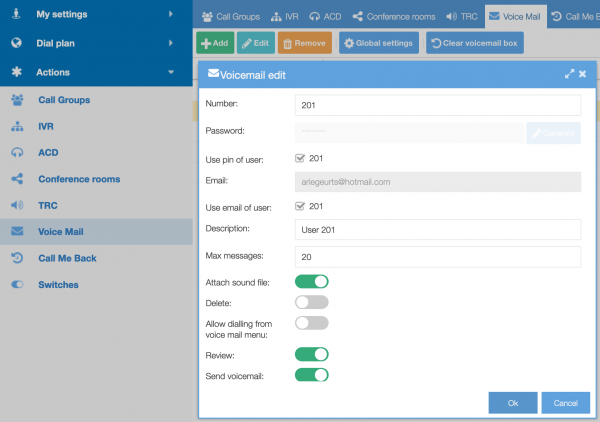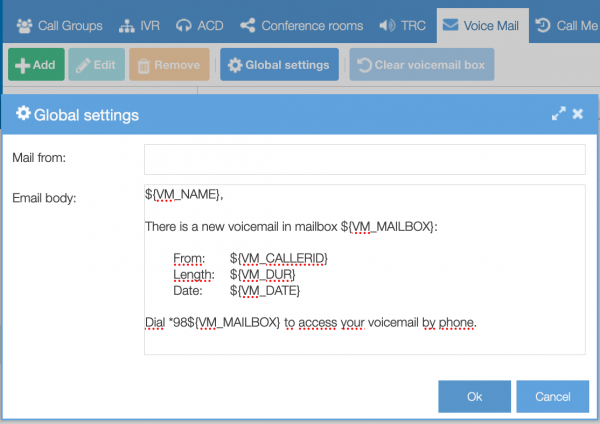Go to Actions/Voic Mail/Add to create a new voicemail.

Settings
- Number: the number that refers to the mailbox, usually made equal to the extension of the user and/or phone;
- Password: a numeric value to access the voicemailbox via the phone menu;
- Email: address where the voicemail as a sound file is sent to, if set;
- Caveat: When a new user is created with a voicemailbox, “Attach sound file” is enabled by default. If you do not provide an e-mail address or if you assign the voicemailbox to a different user, the voicemail messages to this box can’t be sent due to a missing destination address: the voicemail message will be deleted. Either disable ‘attach sound file’ or enter a valid e-mailaddress for the user.
- Description: optional free text field for your own reference;
- Max message: the maximum number of messages in a box. When this number is reached, the next caller cannot leave a message. Default value is 20.
- Note: if the system is running out of disc space, it will start clearing the oldest voicemails first. If the system e-mail address in SMTP settings is set, admin will be notified way in advance before the system starts deleting messages;
- Attach sound file: voicemails will be sent by email as attachment;
- Allow dialing from voice mail menu: users can (remotely) dial in to their voicemail box and make external calls.
- Note: enabling this feature can have security implications;
- Delete: remove voicemail messages from hard disc after the e-mail was sent as an attachment;
- Review: allow the voicemail-box owner to listen to the recorded message before saving;
- Send voicemail: possibility to forward voicemail messages to other users.
It’s possible to remove the default voicemail message when you have recorderd your own sound. Go to your voicemail action rule and set ‘No’ for ‘Play greeting’ and ‘Play instructions’.
Voicemail length: the minimum length of a message is 3 seconds, the maximum length is 300 seconds (5 minutes). No message will be recorded if a caller decides not to leave a voicemail message and simply hangs up within 3 seconds.
Be aware that voicemail messages are removed in the event of a reboot.
Local voicemail rule
When you set a ‘local voicemail’ rule in your dial plan (see also rule editor options), keep the following in mind when it comes to playing soundfiles like greeting and thank you messages;

Prior to version 4.1.6, the greeting was not played when ‘local voicemail’ is the first rule in the dialplan and there is no previous ‘dialstatus’. Meaning the greeting is played if a ‘pbx user’ rule comes before it and that user doesn’t answer the call.
From 4.1.6 and up the greeting is played when set to be played, regardless of prior rules.
Details for other voicemail soundfiles that can be played:
- Unavailable message: played when the user is unavailable. From 4.1.6 and up this is also played when there is no ‘dialstatus’ set (so when ‘local voicemail’ is a solo rule in the dialplan, without preceding ‘pbx user rule’). When there is no custom unavailable message set, a default message is played. You can set a custom unavailable message through dialing the voicemail menu;
- Busy message: played when the user is busy or set to Do Not Disturb. When there is no custom busy message set, a default busy message is played. You can set a custom busy message through dialing the voicemail menu;
- Temporary greeting: overwrites standard messages (both unavailable and busy messages). Once set, it can be removed by choosing option “2” in voicemail/temporary greeting menu (*98 -> pin -> 0 voicemail box options -> 4 temporary greeting -> 2 erase your temporary greeting);
- Through the *98 voicemail menu your can also record the users name. This overwrites your username in standard (non custom) messages e.g. busy message; “The person at extension 401 is on the phone” will be changed to “(recorded name) is on the phone”.
Global settings
Voicemail’s global settings are used to edit the voicemail notification template. Please note that the ‘from’ address defined in voicemail global settings has a higher priority than the one defined in System/Options/Mail SMTP settings.

The variables used by default in the voicemail e-mails are as follows:
${VM_NAME}
${VM_MAILBOX}
${VM_CALLERID}
${VM_DUR}
${VM_DATE}
${VM_CIDNUM}
${VM_MESSAGEFILE}
Besides these you can also use:
${VM_MSGNUM} The number of voicemail messages in the mailbox
${VM_CIDNAME} CALLERID name